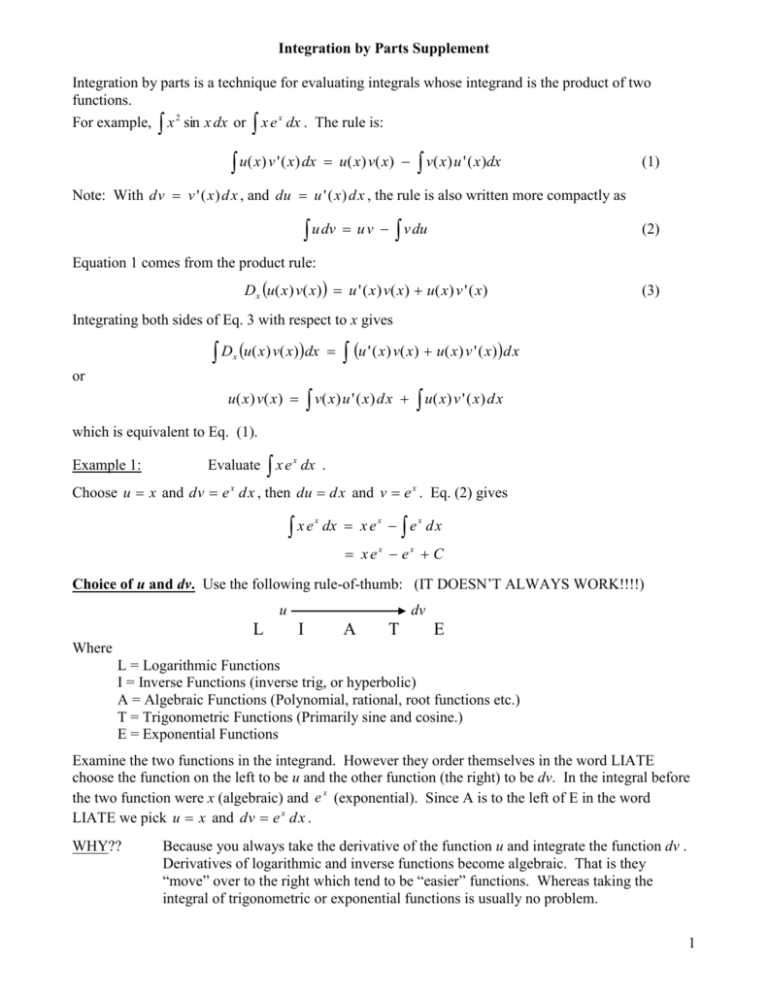Integration by Parts
advertisement

Integration by Parts Supplement Integration by parts is a technique for evaluating integrals whose integrand is the product of two functions. For example, x 2 sin x dx or xe x dx . The rule is: u( x) v ' ( x) dx u( x ) v ( x ) v( x) u ' ( x)dx (1) Note: With d v v ' ( x ) d x , and d u u ' ( x ) d x , the rule is also written more compactly as u dv u v v du (2) Equation 1 comes from the product rule: Dx u( x ) v( x ) u ' ( x ) v( x ) u( x ) v ' ( x ) (3) Integrating both sides of Eq. 3 with respect to x gives D u( x) v( x)dx x u ' ( x) v( x) u( x) v ' ( x)d x or v( x ) u ' ( x ) d x u( x ) v ( x ) u( x ) v ' ( x ) d x which is equivalent to Eq. (1). Example 1: Evaluate xe x dx . Choose u x and d v e x d x , then du d x and v e x . Eq. (2) gives xe x dx x e x e x d x x ex ex C Choice of u and dv. Use the following rule-of-thumb: (IT DOESN’T ALWAYS WORK!!!!) u L dv I A T E Where L = Logarithmic Functions I = Inverse Functions (inverse trig, or hyperbolic) A = Algebraic Functions (Polynomial, rational, root functions etc.) T = Trigonometric Functions (Primarily sine and cosine.) E = Exponential Functions Examine the two functions in the integrand. However they order themselves in the word LIATE choose the function on the left to be u and the other function (the right) to be dv. In the integral before the two function were x (algebraic) and e x (exponential). Since A is to the left of E in the word LIATE we pick u x and d v e x d x . WHY?? Because you always take the derivative of the function u and integrate the function dv . Derivatives of logarithmic and inverse functions become algebraic. That is they “move” over to the right which tend to be “easier” functions. Whereas taking the integral of trigonometric or exponential functions is usually no problem. 1 Repeated integration-by-parts. Using this method on an integral like x 4 e x dx can get pretty tedious. Choose u x 4 and d v e x d x , then du 4 x 3 d x and v e x . Eq. (2) gives x 4 e x dx x 4 e x 4x 3 e x dx The original integral is reduced to a difference of two terms. The resulting integral (on the right) must also be handled by integration by parts, but the degree of the monomial has been “knocked down” by 1. Repeating the process with u 4 x 3 and d v e x d x gives x 4 4x e x dx x 4 e x x4 ex x4 ex 4x 3 3 e x dx e x 12 x 2 e x dx 4 x3 ex 12 x 2 e x dx Repeating this process two more times reduces the integral to x 4 e x dx x 4 e x 4 x 3 e x 12 x 2 e x 24 x e x 24 e x dx (CHECK THIS!!) The last integral is well known so that x 4 e x dx x 4 e x 4 x 3 e x 12 x 2 e x 24 x e x 24 e x C Notice what happened. We started out with a fourth degree monomial times an exponential. Using integration-by-parts 4 times takes 4 derivatives of the original function u x 4 reducing the integral to one easily done. Can you guess how many times integration-by-parts would have to be used to do the integral x 400 e x dx ? You bet: 400. Ouch! There is a better way to handle these types of integrals. Namely integrals of the form x n f ( x ) dx , where n is any positive integer and f(x) is an easily integrable exponential or trigonometric function. Construct a table that looks like the following u x4 dv ex +1 +1 +1 2 Now in the column under u continually take derivatives until you get 0. In the column under dv keep on integrating the function. We get the following table: u x4 4 x3 dv ex ex +1 12 x 2 24 x 24 0 ex +1 +1 ex ex ex Now taking the products shown above gives the previous result x 4 e x dx x 4 e x 4 x 3 e x 12 x 2 e x 24 x e x 24 e x C . As another example consider x 4 cos x dx . we construct the following table u x4 4 x3 dv cos x 12 x 2 24 x 24 0 cos x sin x sin x cos x sin x +1 +1 +1 and deduce that x 4 cos x dx x 4 sin x 4 x 3 cos x 12 x 2 sin x 24 x cos x 24 sin x C (Check This!) Integrands that “never go away.” If the integral in question contains functions that have an infinite number of non-zero derivatives (like exponential or trig functions) then this method does not work so nicely, but you can still use it. Example 2: Evaluate e x cos 2 x dx . Let u cos 2 x and d v e x d x , then d u 2 sin 2 x d x , and v e x , and the integration-by-parts formula gives x x x e cos 2 x dx e cos 2 x 2 sin 2 x e dx Repeating the process, for the integral on the right, now with u 2 sin 2 x and d v e x d x , gives d u 4 cos 2 x d x and v e x and hence e x cos 2 x dx e x cos 2 x 2 e x sin 2 x 4 cos 2 x e x dx Notice we get back a multiple of the original integral. Adding this integral onto the left-hand side gives x x x x e cos 2 x dx 4 cos 2 x e dx e cos 2 x 2 e sin 2 x or 3 Example 2 (cont.) 5 cos 2 x e x dx e x cos 2 x 2 e x sin 2 x Now dividing by 5 and remembering the arbitrary constant gives e x cos 2 x 2 e x sin 2 x x cos 2 x e dx C 5 (CHECK THIS!) Integrands that “have only one function.” When the integrand has only one function, just remember that you can always choose dv dx . Example 3: ln x dx Here choose u ln x and dv dx , in which case du ln x dx 1 dx and v x . Equation 2 gives x x ln x dx x ln x x C Example 4: arctan (1 / x) dx Here choose u arctan (1 / x ) and dv dx , in which case du 1 dx and v x . Equation 2 x 1 2 gives arctan (1 / x ) dx x dx 1 x arctan (1 / x ) x x arctan (1 / x ) 1 ln x 2 1 C 2 2 4








